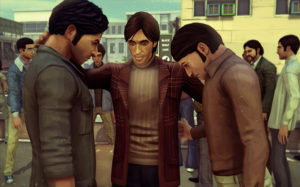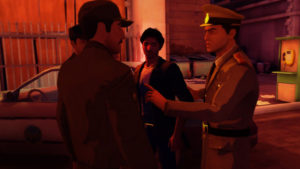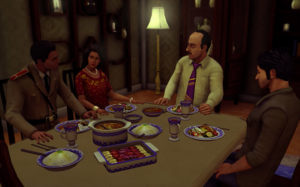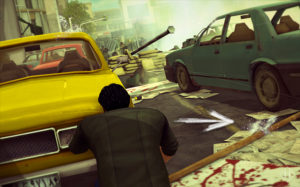
Ever since I played the original season of The Walking Dead from Telltale I was hooked on narrative games. With their tragic closure comes a loss of consistently terrific adventures, and while some other developers like DONTNOD (creators of the Life is Strange games) still put out great narrative games, there are few others that do the same.
I’m gonna be honest, when I first heard that a game called 1979 Revolution: Black Friday was up for review I originally assumed it was going to be some sort of silly game about surviving the horrors of an American Black Friday set back in 1979 for some reason. I felt rather terrible for joking to myself about it when I found out it was actually about the Iranian Revolution, which included one especially horrific day called Black Friday. As soon as I learned what the game was actually about I wanted it; nothing interests me more than a narrative game that teaches me while it entertains me!

1979 Revolution: Black Friday puts you in the shoes of a man named Reza, and the opening scene has you being caught and brought to Evin Prison discussing events you’re unaware of with a vicious interrogator. The game then flashes back to 1978 where Reza is talking to his friend Babak and taking photos of people filling the streets in peaceful protest of the Shah – the ruler of Iran at the time. Reza had been in Germany for a year, making for a perfect excuse to learn about what Iran is going through.

Reza is swept up in the revolution thanks to his friend Babak and his cousin Ali. The two both have the same goal but differing methods in achieving it. Babak believes in peaceful protest, whereas Ali believes that violence is necessary, especially in retaliation. The leader of their group in the rebellion, Abbas, also believes in peaceful protesting but Ali is far from the only one who believes that change can come from peacefulness. As the player you’re able to side with Babak or Ali repeatedly throughout the story, whether it’s something obvious like directly siding with one or the other in an argument or by resisting the urge to punch someone who attacked you or choosing to throw rocks at SAVAK, the Shah’s “secret” police who don’t seem so secret.

What really surprised me about 1979 Revolution: Black Friday was just how immersive it felt despite the flaws with the game itself. When loading up the game it says that the game is “designed as a headphones experience”, and I couldn’t agree more. With headphones on I could feel the crowd chanting around me as protests and riots were happening, and when bullets started flying on Black Friday it was terrifying! Early in the game you can even hear a radio broadcast playing over the crowd, and can choose to change the language on it to Farsi if you’d like! The voice acting is terrific, and so was the cast. I knew I recognized the interrogator’s voice, but was surprised to find it was Navid Negahban who plays Amahl Farouk in Legion. Omid Abtahi voices Babak, and had previously played a large role in the show Sleeper Cell. All of the actors did a terrific job, but these were the two I really recognized outside of games in other media that I enjoyed so much I recognized their faces immediately.

In addition to the voice acting, the game also tells its tale through recordings you come across. Free speech wasn’t a thing in Iran in 1979, and people could actually be put to death or at least arrested and detained for their words. As such, people often passed around cassettes of speeches to spread the words of rebellion leaders. In fact, words are so dangerous that Babak gives you a cassette early in the game and warns you not to listen to it at home. And the same is true of photographs, another big part of 1979 Revolution: Black Friday. You’re a photographer, so one of the main things you do is take photos. Usually you take them while walking around – you’re presented with specific spots you can take photos and pull out your camera with a button – but sometimes you also take them during big events, such as your first protest where Abbas is assaulted. Photography is done through a minigame: first you aim the center of your lens at a viable spot and the icon turns green, then you snap the photo as the meter that slides back and forth hits the center. If you time it right you’ll snap the photo correctly, which then brings up a comparable real photograph and a bit of information regarding what you found. Sometimes you’ll even get a bit of dialog, like when Babak tells you that if you inspect any of the guns SAVAK uses you’ll find “USA” written on them.

As you pick up collectibles, talk to people, experience events, and take photographs you’ll unlock them in the Stories section. The text is a bit hard to read on these, but bringing the portable Switch close to my face made it mostly painless. These make a great optional way to get more information about the events going on, and it’s cool to see your photo collection as well!
What I really love about 1979 Revolution: Black Friday was that I learned a lot about Iran, the Iranian Revolution, and even more importantly I was able to see people of the middle east in a new light. It seems like the vast majority of Middle Eastern folks shown in the US, especially when it comes to any sort of religion, are terrorists or questionable characters at best. It was refreshing to see an entire game based in Iran, and to get a glimpse into some celebrations, foods, outfits, and customs of the time. It was also awesome how even the few “bad” characters in the game had good reasons for it, and none of them were one dimensional. Your brother in the game, Hossein, is actually part of SAVAK himself. At one point Babak tells you that many people joined SAVAK because they couldn’t find work and their families were starving. They essentially chose between accepting the job or letting their loved ones go hungry and even potentially die. Ali, the violent cousin who may have actually bombed numerous spots in the past, even has reasons for his violence. He’s seen the ineffectiveness of peaceful protest, he sees how many suffer for it, so he does what he feels he has to do. Heck, you may even feel bad for your interrogator for a few minutes due to things that have happened in his past!

But my favorite part of all was a segment where you go home to your parents. Here you see what your parents think of the revolution, sure, but there’s also a load of genuine, real-life content here. There’s a slew of photos in your father’s study and even a stack of home movies that you can watch. I started off watching them thinking maybe I’d unlock something, but then I realized just how great they were and how well they set the stage for Reza and his parents being REAL PEOPLE in a way I’ve rarely ever seen in games. His family is interesting with the way each person has their own thoughts on the revolution and plays a different part in it, yet they come together to have dinner and talk like any other family would.
This is a shame because it seems like the rest of the game doesn’t capitalize on that potential. Although I felt very immersed with the writing and the quick choices and all of the sounds, there was a lot more potential for the characters. Speaking of quick choices, it felt like a lot of times I barely had time to choose out of the four choices before time ran out, and I’m quite a speed reader. On the opposite end of the spectrum, load times were a bit painful sometimes, especially when it came to a part where I died repeatedly. It seemed like around 10-15 seconds of load time between deaths, and then about 15-20 seconds until I’d die again. This was the only part of the game I actually died in, which was fitting since it was a particularly crazy portion of the game narratively as well.

Walking portions of the game were also a bit rough sometimes as I never found a run button, especially since I wanted to explore everything and get every bit of info I could. Babak, who followed you around most of the game, loved to block my path if I ever turned around too. Also, at first it seemed like taking a photo of something once removed the ability to take another photo of it. Once all of the photos in a spot were done, you wouldn’t even be able to enter photography mode there, making it clear that you’ve completed it and could move on. After the first couple times this no longer happened, so I’d have to scan the camera over everything I could to make sure I didn’t miss anything, especially since there’s no indicator that you’re getting close to something you can photograph.
Overall 1979 Revolution: Black Friday was a terrific experience, but not a really great game. It’s an easy recommendation to anyone who enjoys narrative games or is interested in learning through gameplay, especially those interested in Iran. But if you’re the type of person who doesn’t like Telltale Games because they’re not “game” enough, you’ll almost certainly find the same issue here as well. This game is much shorter since it’s essentially one “episode”, and only takes around 2-3 hours to complete, but at least you don’t have to worry about a season pass or waiting months for the rest of the story! One thing is for sure: I’ll be keeping an eye out for future iNK Stories releases!
Note: 1979 Revolution: Black Friday doesn’t allow the player to take screenshots while playing on the Nintendo Switch, so every image used in this review comes from the official website and the game’s Steam page.
1979 Revolution: Black Friday is available for Nintendo Switch (reviewed), Xbox One, PlayStation 4, Google Play, iOS, and Steam (Windows, Mac).
I received a free copy of this game in exchange for an honest review.

